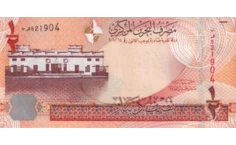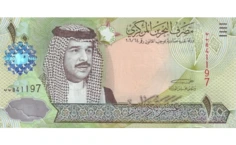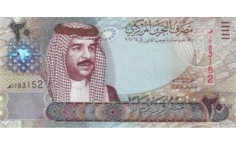Guide to Detecting Counterfeit Bahraini Dinar (BHD) Notes
Exchange Foreign Currency Now
How to Identify Counterfeit BHD (د. ب) Currency Notes
For Indian travellers planning a trip to the Kingdom of Bahrain, ensuring the authenticity of your currency is paramount. Whether you're exchanging Indian Rupees (INR) for Bahraini Dinars (BHD) at home or abroad, knowing how to spot a fake can save you from significant inconvenience and embarrassment. This guide focuses on the security features of the Fourth Issue of Bahraini Dinar banknotes (introduced in 2008).
Key Security Features of Bahraini Dinar Bank Notes
Raised Printing (Intaglio):
Certain elements on genuine BHD banknotes are printed using an intaglio process, which creates a noticeable raised texture that you can feel with your fingertips.
Watermark:
To check the watermark, hold the banknote up to a light source. In the unprinted white area of the note, you should see a multi-tonal watermark of His Majesty King Hamad bin Isa Al Khalifa's portrait.
Security Thread:
All Bahraini Dinar banknotes contain a metallic security thread embedded vertically within the paper. When you hold the banknote up to the light, this thread should appear as a continuous, bold, dark line running through the BHD note.
Colour-Changing Ink:
On the upgraded 10 and 20 Dinar notes (from 2016), a specific design element (often a prominent circular feature or part of the denomination) is printed with colour-changing ink. When the banknote is tilted, this element exhibits a colour shift.

See-Through Register:
On the banknote, you will find a design element printed partially on the front and partially on the back. When you hold the banknote up to the light, both parts must align perfectly to form a complete and clear image.
Iridescent Stripe:
On the reverse side, there is a glossy, transparent stripe running vertically. When you tilt the banknote under light, this stripe will reveal the denomination numeral (e.g., "½", "1", "5") in both Arabic and English, along with the CBB logo.
Microprinting:
It involves printing incredibly tiny text or numerals that are almost imperceptible to the naked eye. On BHD notes, this microtext (e.g., "CBB", "BAHRAIN CENTRAL BANK", or the denomination) will be clearly visible.
UV Features (Fluorescence):
Under ultraviolet (UV) light, specific design or security elements will glow in various distinct colours. For example, the serial numbers on the note will often glow in yellow colour.
Tactile Marks for Visually Impaired:
To assist visually impaired individuals, a series of short, raised lines is consistently located at the centre-right on the front of each banknote. By feeling these lines, one can identify the denomination.
A Detailed Guide to Identifying Counterfeit BHD Currency by Denomination
The Central Bank of Bahrain (CBB) issued its Fourth Issue of banknotes in 2008, followed by upgraded versions of the 10 and 20 Dinar notes in 2016 with enhanced security features. All notes from the 2008 series (and its subsequent upgrades) remain legal tender.
| Denomination | Colour | Security Thread | Color-Shifting Ink | UV Features | Tactile Marks |
|---|---|---|---|---|---|
| ½ Dinar | Orange & Brown | Windowed (Green→Red) | Not present | Serial no. + fibres + logo | 1 raised line |
| 1 Dinar | Red | Windowed (Green→Red) | Not present | Serial no. + fibres + building | 2 raised lines |
| 5 Dinars | Blue | Windowed (Green→Red) | Not present | Serial no. + fibres + design elements | 3 raised lines |
| 10 Dinars (2016) | Green | Motion thread (dynamic) | SPARK ink (Green→Gold) | Serial no. + fibres + patterns | 4 raised lines |
| 20 Dinars (2016) | Brown & Light Blue | Motion thread (dynamic) | SPARK ink (Green→Gold) | Serial no. + fibres + motifs | 5 raised lines |

½ Dinar Banknote (Dominant Colour: Orange and Brown)
- Raised Printing (Intaglio): Feel the raised printing on the portrait of King Hamad on the front, the large numeral "½", the Arabic text for "Central Bank of Bahrain", and the design patterns surrounding the main image.
- Watermark: Hold the note to light. A multi-tonal portrait of King Hamad appears in the white unprinted area on the left. Below it, the electrotype text "HALF" (and its Arabic equivalent) is also visible.
- Security Thread: A windowed security thread runs vertically to the right of the portrait. It appears as a continuous dark line against light and shows demetalized "CBB" repeating along its length. The colour shifts from green to red when the note is tilted.
- Colour-Changing Ink: This feature is not present on the ½ Dinar banknote.
- See-Through Register: Hold the note to the light. A geometric pattern or part of the CBB logo, printed partially on the front and back (typically to the left of the main image area), aligns perfectly to form a complete image.
- Iridescent Stripe: On the reverse side, a shimmering transparent stripe is located vertically on the right side. When tilted, it reveals the numeral "½" in both Arabic and English.
- Microprinting: Using a magnifying glass, look for tiny, sharp text such as "CBB" or "BAHRAIN CENTRAL BANK" integrated within the fine lines of the background design, for example, around the portrait or along the borders of the note.
- UV Features (Fluorescence): Under UV light, the serial numbers (on the front) will fluoresce. Security fibres embedded throughout the paper will appear as glowing red, blue, and green threads.
- Tactile Marks for Visually Impaired: One short, raised line is located at the centre-right on the front of the BHD banknote.

1 Dinar Banknote (Dominant Colour: Red)
- Raised Printing (Intaglio): Feel the Al Hedaya Al Khalifiya school building image on the front, the large numeral "1", and the Arabic text for "Central Bank of Bahrain" for raised texture.
- Watermark: Hold to light. A multi-tonal portrait of King Hamad appears in the white unprinted area. Below it, the electrotype text "ONE" (and its Arabic equivalent) is also visible.
- Security Thread: A windowed security thread runs vertically to the right of the portrait. It appears as a continuous dark line against light and shows demetalized "CBB" repeating along its length. The colour shifts from green to red when the note is tilted.
- Colour-Changing Ink: This feature is not present on the 1 Dinar banknote.
- See-Through Register: Hold the note to the light. A geometric pattern or part of the CBB logo, printed partially on the front and back (typically to the left of the main image area), aligns perfectly to form a complete image.
- Iridescent Stripe: On the reverse side, a shimmering transparent stripe is located vertically on the right side. When tilted, it clearly reveals the numeral "1" in both Arabic and English.
- Microprinting: Using a magnifying glass, look for tiny, sharp text such as "CBB" or "BAHRAIN" integrated within the fine lines of the background design, for example, around the school building or along the borders.
- UV Features (Fluorescence): Under UV light, the serial numbers (on the front) will typically fluoresce in yellow or green. Security fibres embedded throughout the paper will glow in various colours (red, blue, green). Specific design elements (e.g., patterns on the school building) may also fluoresce in distinct colours.
- Tactile Marks for Visually Impaired: Two short, raised lines are located at the centre-right on the front of the banknote.

5 Dinars Banknote (Dominant Colour: Blue)
- Raised Printing (Intaglio): Feel the images of Shaikh Isa House and Riffa Fort on the front, the large numeral "5", the Arabic text for "Central Bank of Bahrain", etc for raised texture.
- Watermark: Hold the note to light. A multi-tonal portrait of King Hamad appears in the white unprinted area. Below it, the electrotype text "FIVE" (and its Arabic equivalent) is clearly visible.
- Security Thread: A windowed security thread runs vertically to the right of the portrait. It appears as a continuous dark line against light and shows demetalized "CBB" repeating along its length. The colour shifts from green to red when the note is tilted.
- Colour-Changing Ink: This feature is not present on the 5 Dinars banknote.
- See-Through Register: Hold the note to the light. A geometric pattern or part of the CBB logo, printed partially on the front and back (typically to the left of the main image area), aligns perfectly to form a complete image.
- Iridescent Stripe: On the reverse side, a shimmering transparent stripe is located vertically on the right side. When tilted, it reveals the numeral "5" in both Arabic and English.
- Microprinting: Using a magnifying glass, look for tiny, sharp text such as "CENTRAL BANK OF BAHRAIN" or the denomination, precisely printed within the fine lines of the architectural details (e.g., on the fort or house) or in the background patterns.
- UV Features (Fluorescence): Under UV light, the serial numbers will fluoresce. Multi-colored security fibres will glow throughout the paper. Specific design elements (e.g., parts of the buildings, patterns on the smelter and oil well on the reverse) will become visible or glow in distinct colors.
- Tactile Marks for Visually Impaired: Three short, raised lines are located at the centre-right on the front of the banknote.

10 Dinars Banknote (Dominant Colour: Green - Upgraded 2016 Version)
- Raised Printing (Intaglio): Feel the portrait of King Hamad on the front, the "Central Bank of Bahrain" text, the large numeral "10", etc for raised texture.
- Watermark: Hold to light. A multi-tonal portrait of King Hamad appears in the white unprinted area. Below it, the electrotype text "TEN" (and its Arabic equivalent) is clearly visible.
- Security Thread: A motion security thread runs vertically to the right of the portrait. It appears as a continuous dark line against light. When tilted, it displays dynamic movement effects (e.g., small squares or patterns appearing to move along the thread's length) and has demetalized Arabic text and "10".
- Colour-Changing Ink: A prominent circular feature on the front, left side, is printed with SPARK ink. When tilted, this feature exhibits a striking color change (e.g., from green to gold) and a distinct rotating circle effect within the ink patch.
- See-Through Register: Hold the note to light. A specific design element (e.g., a part of the CBB emblem or a geometric pattern) printed partially on the front and partially on the back, aligns perfectly to form a complete and clear image.
- Iridescent Stripe: This feature is not a primary, prominent feature on the upgraded 10 Dinar banknote; the Motion thread and SPARK ink provide enhanced dynamic security.
- Microprinting: Using a magnifying glass, very fine microtext, such as "BAHRAIN CENTRAL BANK" or "TEN DINARS," is embedded within the fine lines of the background patterns, especially around the portrait or borders.
- UV Features (Fluorescence): Under UV light, the serial numbers will fluoresce (in yellow or green). Multi-colored security fibres will glow throughout the paper. Specific patterns or graphic elements (e.g., parts of the bridge image on the reverse, or hidden text/symbols) will glow in distinct colors.
- Tactile Marks for Visually Impaired: Four short, raised lines are located at the center-right on the front of the banknote.

20 Dinars Banknote (Dominant Colour: Brown and Light Blue - Upgraded 2016 Version)
- Raised Printing (Intaglio): Feel the portrait of King Hamad on the front, the "Central Bank of Bahrain" text, the large numeral "20", etc for raised texture.
- Watermark: Hold to note light. A multi-tonal portrait of King Hamad appears in the white unprinted area. Below it, the electrotype text "TWENTY" (and its Arabic equivalent) is visible.
- Security Thread: This note features a Motion security thread running vertically. When held to light, it appears as a continuous dark line. When tilted, it displays dynamic movement effects (e.g., small squares or patterns appearing to move along the thread's length) and has demetalized Arabic text and "20".
- Colour-Changing Ink: A prominent circular feature on the front, left side, is printed with SPARK ink. When tilted, this feature exhibits a striking color change (e.g., from green to gold) and a distinct rotating circle effect within the ink patch.
- See-Through Register: Hold the note to light. A compass rose (or other specific geometric shape) printed partially on the front and partially on the back, aligns perfectly to form a complete and clear image.
- Iridescent Stripe: This feature is not a primary, prominent feature on the upgraded 20 Dinar banknote; the Motion thread and SPARK ink provide enhanced dynamic security.
- Microprinting: Extensive and extremely fine microtext is present in various intricate patterns, for example, within the lines surrounding the portrait, in the background security patterns, or in the outline of large numbers.
- UV Features (Fluorescence): Under UV light, the serial numbers will fluoresce brightly (often in yellow or green). Multi-colored security fibres will glow throughout the paper. Numerous other patterns or elements (e.g., parts of the mosque's architecture, specific motifs) will fluoresce as well.
- Tactile Marks for Visually Impaired: Five short, raised lines are located at the center-right on the front of the banknote.


